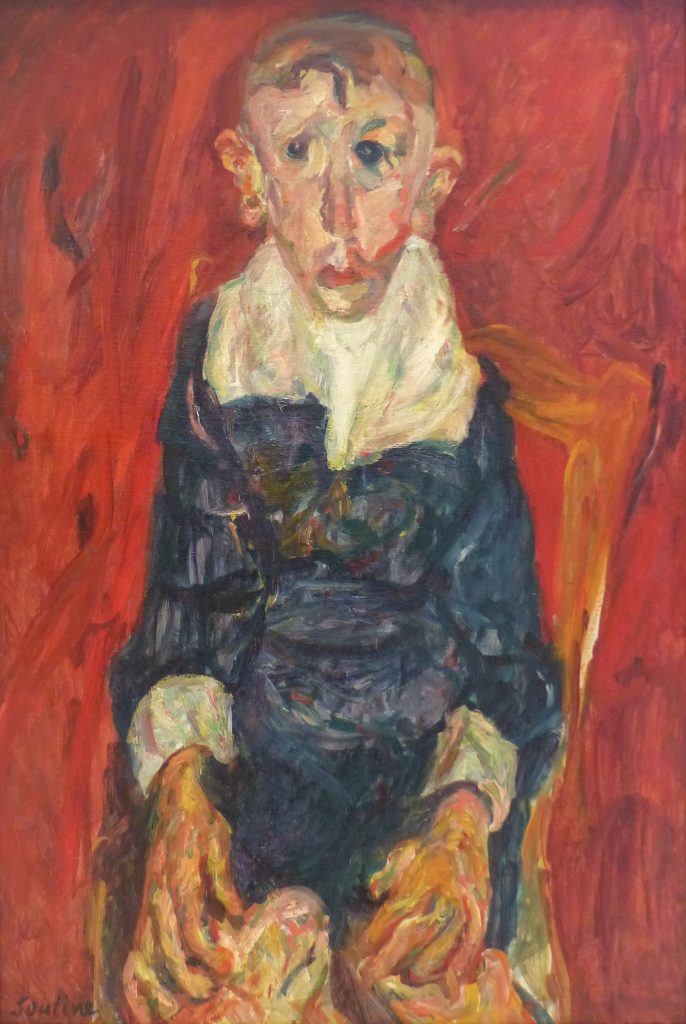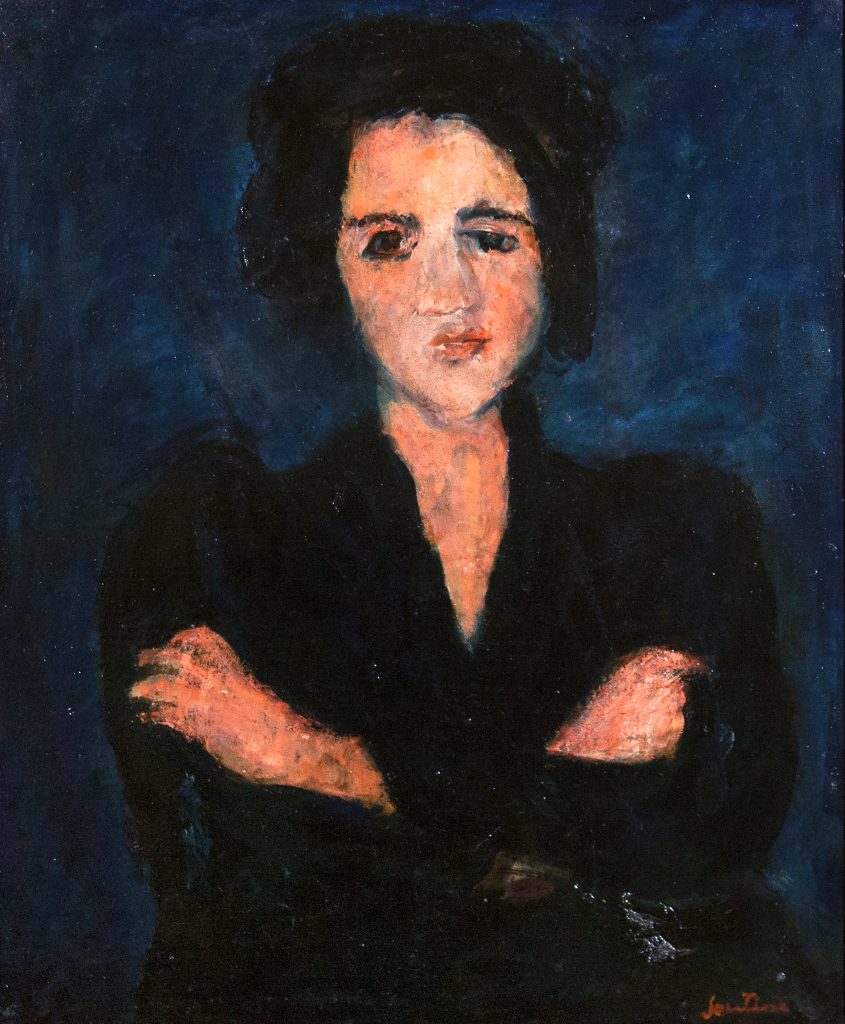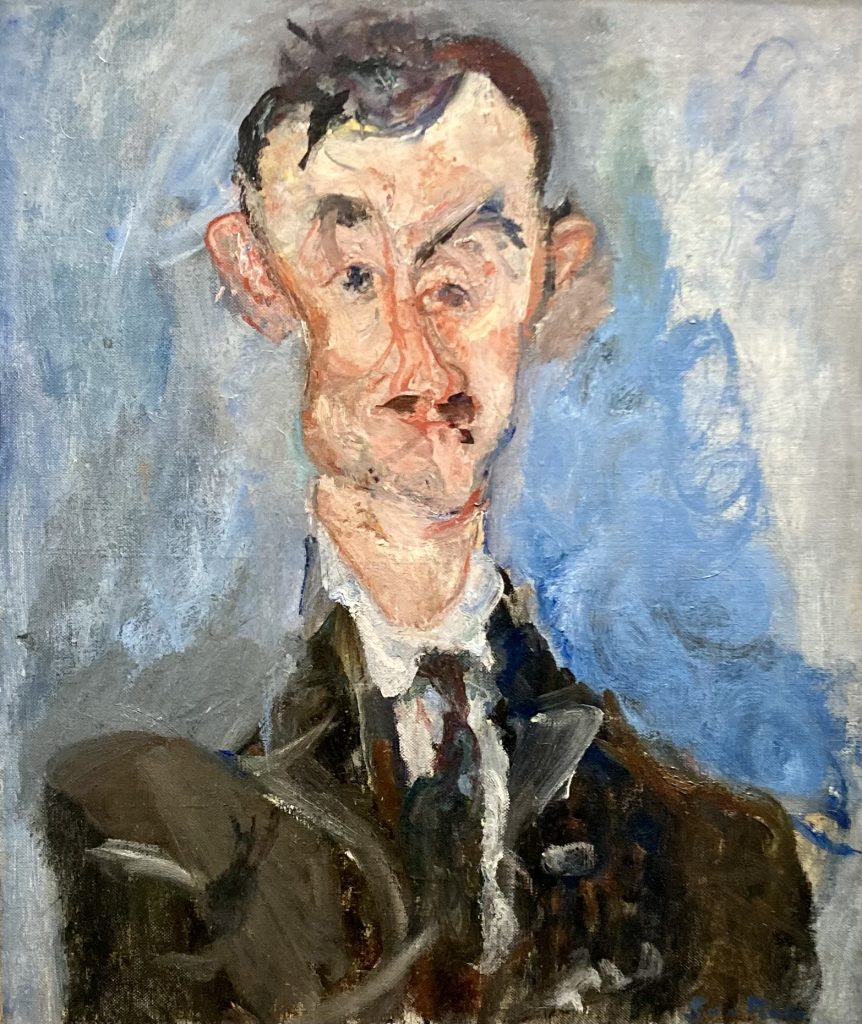
Chaim Soutine was born in 1893 in the small, impoverished Jewish shtetl of Smilavichy, near Minsk, in what was then part of the Russian Empire (now Belarus). The exact date of his birth is disputed—some sources place it on January 13, others on January 19—but what is certain is that he grew up in grinding poverty as one of eleven children in a deeply religious Orthodox Jewish family. His father was a tailor, and the household adhered strictly to Jewish tradition, which often meant a life circumscribed by religious study and community rules.
Soutine’s early exposure to art was limited, but he displayed a strong attraction to drawing from a young age. This did not sit well with his family or the community’s rabbi, as depictions of human figures were viewed with suspicion in a traditional Jewish setting. There’s a famous, possibly apocryphal, story that a beating from the son of a local rabbi over one of Soutine’s drawings prompted his family to take legal action, eventually securing a small monetary settlement. This money, according to legend, became part of the fund that allowed Soutine to leave Smilavichy to study art.

At around 16, Soutine moved to Minsk and then to Vilnius (then known as Vilna), where he enrolled in the Vilna Academy of Fine Arts. It was here that he first received formal training in drawing and painting, learning basic academic techniques and developing the discipline that would later underpin his wildly expressive style. Even in these early years, his work leaned toward distortion and emotional intensity, setting him apart from more restrained realist painters.
Journey to Paris and the École des Beaux-Arts (1913–1914)
In 1913, Soutine left the Russian Empire for Paris, joining a wave of Eastern European Jewish artists who saw the French capital as the center of the art world. He entered the École des Beaux-Arts, studying under Fernand Cormon, whose previous students had included Van Gogh, Toulouse-Lautrec, and Émile Bernard. While Cormon’s teaching leaned toward traditional academic painting, Paris itself was teeming with new artistic movements—Post-Impressionism, Fauvism, and Cubism were all flourishing.

Soutine settled in La Ruche (“The Beehive”), an artists’ residence in the Montparnasse district that housed a diverse group of struggling painters, poets, and sculptors. There he befriended Amedeo Modigliani, a fellow outsider in both ethnicity and temperament. Modigliani recognized Soutine’s talent, encouraged him, and even painted his portrait several times. Their friendship would be one of the defining relationships of Soutine’s Paris years, providing both artistic support and personal companionship.
Struggle, Hunger, and a Distinctive Style (1914–1922)
Life in Paris was not easy for Soutine. The outbreak of World War I in 1914 worsened the already precarious conditions for foreign artists. Money was scarce, and Soutine often went hungry, wearing the same tattered clothes for years. Yet this period saw him develop the signature traits of his mature style: thick impasto, swirling brushstrokes, and distorted forms that conveyed an intense emotional charge.
Soutine’s early subjects were still lifes, portraits, and landscapes, but unlike the calm arrangements of Cézanne or the gentle portraits of Renoir, his paintings pulsed with nervous energy. Influences from Rembrandt and El Greco filtered through his work, but so did a visceral quality—flesh, fabric, and trees seemed to tremble under his brush. Many of his landscapes from this time, particularly those painted in Céret in the French Pyrenees between 1919 and 1922, show buildings and trees that twist and sway as if caught in an invisible wind.
His Céret period was intense but isolating. He painted feverishly, producing some of his most famous works—The Old Village, The Bridge at Céret, View of Céret—but his health suffered from poor diet and loneliness. Soutine later said that the colors and distortions of his landscapes came not from an abstract desire for style, but from the way the world looked to him in a state of exhaustion and hunger.
Breakthrough: The Barnes Collection Purchase (1922–1923)
Soutine’s life changed dramatically in 1922 thanks to a twist of fate involving an American art collector. Dr. Albert C. Barnes, founder of the Barnes Foundation in Pennsylvania, visited Paris and saw one of Soutine’s paintings in the gallery of dealer Léopold Zborowski. Barnes was captivated by the raw energy of Soutine’s work and, in a move that instantly transformed the artist’s fortunes, bought more than 50 of his paintings on the spot.
This purchase brought Soutine financial stability for the first time in his life. His paintings began to sell steadily, and he could now afford better living conditions and materials. The Barnes acquisition also placed his work in a prestigious American collection, ensuring his reputation abroad. Soutine’s status rose quickly in the Paris art world; critics began to see him not as an eccentric outsider but as a leading figure of modern expressionist painting.
The Carcass Paintings and Exploration of Flesh (1923–1925)
Freed from the crushing anxiety of poverty, Soutine embarked on some of his most daring series. Among these were his carcass paintings, inspired by Rembrandt’s The Slaughtered Ox. Soutine would buy animal carcasses—beef, poultry, rabbits—and set them up in his studio, painting them as they decayed. His obsession with these works alarmed neighbors, who complained about the smell, but Soutine persisted, fascinated by the colors and textures of flesh in various stages of decomposition.
Far from being morbid for its own sake, this series reflected Soutine’s interest in the fragility of life and the beauty hidden in decay. The reds, blues, and yellows in these paintings are astonishingly vivid, and the brushwork borders on the violent. Works like Carcass of Beef and Hanging Turkey stand among his most intense achievements, blending the grandeur of Old Master painting with the immediacy of modern expressionism.
Portraiture and Human Character (1925–1935)
In addition to still lifes and landscapes, Soutine was a formidable portraitist. He painted cooks, bellboys, chambermaids, and hotel porters, capturing their dignity and humanity despite their humble occupations. This series—sometimes referred to as his “servants” paintings—contrasted sharply with the idealized portraits common in high society circles. Soutine gave these subjects a kind of monumental presence, their uniforms rendered with bold colors and textures that seemed almost sculptural.
He also painted more formal portraits, including Portrait of Madeleine Castaing, a French decorator and one of his patrons. Castaing, known for her eccentric fashion and taste, was a strong supporter of Soutine, purchasing many of his works and helping to promote his reputation.
By the late 1920s and early 1930s, Soutine’s work had gained an international audience, with exhibitions in the United States and Europe. Yet despite success, he remained a deeply private and troubled man, often retreating from the social circles that celebrated him.
Decline, War, and Final Years (1937–1943)
The late 1930s brought mounting challenges. Soutine’s health, never robust, deteriorated due to chronic stomach ulcers and the stress of his perfectionism—he was notorious for destroying canvases that failed to meet his exacting standards. Politically, the rise of Nazi Germany and the outbreak of World War II made life increasingly dangerous for a Jewish artist in France.
When Germany occupied Paris in 1940, Soutine fled to the unoccupied zone in southern France. He moved frequently, living under assumed names to avoid detection. Despite the danger, he continued to paint, though his output was limited by poor health and the scarcity of materials. His paintings from this period are darker in tone, perhaps reflecting both personal suffering and the grim realities of wartime France.
By 1943, Soutine’s ulcers had worsened to the point of requiring urgent surgery. He was smuggled back into Paris in the middle of the night for an operation, but it was too late. Chaim Soutine died on August 9, 1943, at the age of 50, and was buried in Montparnasse Cemetery. Modigliani’s widow, Jeanne Hébuterne, who had taken her own life in 1920, was buried nearby—a poignant reminder of the fragile community of émigré artists that had once thrived in Paris.
Legacy and Influence
Soutine’s work occupies a unique place in 20th-century art. While associated with the School of Paris, he never fully aligned with any single movement. His expressionism was intensely personal, rooted not in theory but in lived experience—hunger, displacement, illness, and a relentless drive to capture the trembling vitality of life. His influence can be seen in the work of later artists such as Francis Bacon, Willem de Kooning, and Lucian Freud, all of whom admired his visceral brushwork and uncompromising vision.
Today, Soutine’s paintings are housed in major museums, including the Barnes Foundation, the Musée de l’Orangerie in Paris, and the Tate in London. His market value has soared, but more importantly, his work continues to resonate with viewers for its combination of raw emotion and painterly mastery. In a career cut tragically short, he produced a body of work that remains among the most intense and original contributions to modern art.
Key Themes in Soutine’s Art
- Distortion as Truth – Soutine’s twisting forms were not mistakes but deliberate attempts to convey the inner life of his subjects.
- Color as Emotion – His palette was often electric, using reds, blues, and yellows to heighten the emotional impact.
- Human Dignity – His portraits of workers elevated everyday people to subjects worthy of monumental art.
- Mortality and Decay – The carcass paintings were meditations on impermanence, finding beauty in the inevitable process of decline.
- Isolation and Identity – As a Jewish immigrant in France, Soutine’s outsider perspective shaped his artistic vision.




